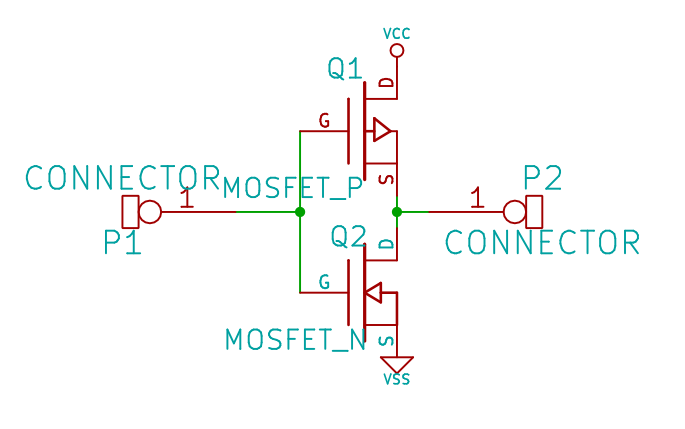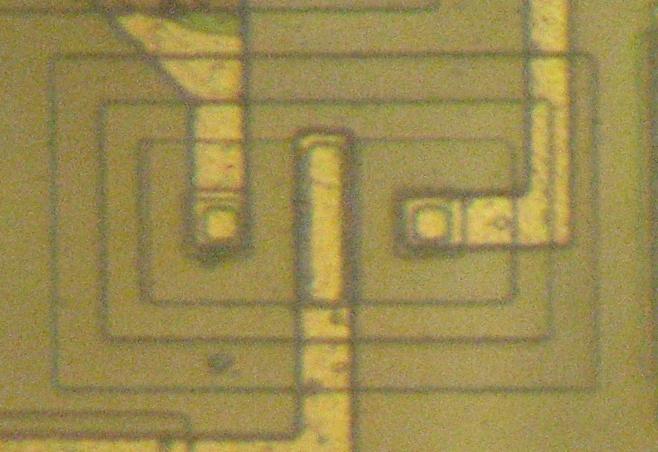This is an old revision of the document!
Table of Contents
You should understand basic MOSFETs before understanding CMOS
Conceptual
Complimentary metal oxide semiconductor FET (CMOS) technology is based on the idea that you have two types of transistors:
- Positively doped transistors that conduct when presented with a low voltage
- Negatively doped transistors that conduct when presented with a high voltage
For example, here is a schematic of a basic inverter:
V+ is at the top and V- at the bottom with input to the left and output on the right. When low voltage (0) comes in the top mosfet conducts V+ to give a 1 at the output. Conversely, when high voltage (1) comes in the bottom mosfet conducts V- to yield a 0 at the output.
Basic layout
With the above in mind lets see how one is physically made. This example is an inverter from a standard cell based IC (SecurID).
Active
First here is the active area:
From a pure logic standpoint one could assume either side was PMOS or NMOS as long as they were consistent. However, PMOS tends to be slower and larger to compensate so we know that the right side is P doped and thus the left is N doped The wells on the furthest sides can be ignored for the purpose of determining the logical structure other than to note that they will follow power rails. For the curious, they are called a “guard bar” and help prevent latchup just like in the MOSFET example above. The two tick marks in the middle are etch marks and not part of the layout.
Poly
Heres the next layer with the poly:
Now we have formed transistors. With the poly crossing the active area the electron concentration can be changed as the gate capacitor charges or discharges. This effectively turns the transistor on or off. However, the transistors aren't hooked up to anything. Each has three terminals but they don't go anywhere.
Typical poly gate transistor from a typical standard cell based IC. Some of the contact metal can be seen on the bottom but the gate itself is poly.
Metal
This finally connects things together:
Note that the above photo has two metal layers. M1, physically the lowest layer, is part of the standard cell. M2, the top metal layer, is what the IC designer end user uses to make something useful out of standard cells. The M1 simply connects everything together to make a useful circuit:
- One side of the PMOS transistor to V+ (top right)
- One side of the NMOS transistor to V- (top left)
- The other side of each together (bottom metal strip)
- Both poly gates together to the input contact (middle top metal blob)
- The output (between the two transistors) to an output contact (middle bottom blob)
Note the small circles / squares between the metal and poly and active areas. These contacts connect the metal to the poly and active areas. And there we have it. See the standard cell library examples for more complicated scenarios.
Early metal gate
While CMOS has seen a recent metal gate comeback, CMOS has traditionally been dominated by poly gates. However, early chips like the CD4000 series used aluminum gates.
Above (unknown CD4000 IC) shows a near textbook aluminum gate transistor.
Metal Gate Technology for Advanced CMOS Devices: “early CMOS processes used aluminium gates in the 1970’s. As scaling continued, n + polysilicon was used as a gate electrode instead due to its ability to withstand heat treatments necessary to activate the source and drain dopants.”
Contemporary metal gate
Closely associated with high k dielectrics
References
1970 IGFET patent “INSULATED GATE COMPLEMENTARY FIELD EFFECT TRANSISTORS GATE STRUCTURE”
- MOSFET patent?
Electric field controlled semiconductor device
- FET patent?






